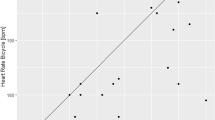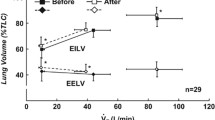Abstract
The parameters used to assess aerobic exercise function by gas exchange are usually adjusted for body mass and are expressed as millilitres per minute per kilogram. In the case of obese children this could lead to overcorrection with an underestimation of their exercise capacity. The purpose of the present study was to assess cardiorespiratory exercise function in obese subjects using body mass-independent parameters. As both carbon dioxide output (˙VCO2) and oxygen uptake (˙VO2) are usually corrected for body mass, the slope of ˙VCO2 versus ˙VO2 can be considered to be independent of body mass. This slope was calculated below the ventilatory threshold (S1) and above the ventilatory threshold (S3). Exercise tests were performed on a treadmill and respiratory gas exchange was measured breath-by-breath. A group of 29 obese children [mean age 11 (SD 2.5) years] were compared to 16 normal controls of the same age range [mean age 10.8 (SD 2.2); P > 0.05. The patients were overweight by 36 (SD 17.9)% and had a body mass index of 25.0 (SD 3.8). The results showed that S3 in the obese subjects was significantly steeper compared to the normal controls [1.30 (SD 0.20) vs 1.10 (SD 0.20); P < 0.05. The steepest values for S3 were found in the subjects with the highest degree of obesity. This method has some limitations, since in a large proportion of the patients (48%) no ventilatory threshold could be detected, which is prerequisite for calculation of these slopes. The latter was already suppressed at the onset of exercise in 21% of the sample or could not be detected because of breathing irregularity in 27%. It is suggested from this study that cardiorespiratory exercise function in obese children is reduced, especially when assessed by parameters of aerobic exercise which cancel the confounding effect of body mass.
Similar content being viewed by others
Author information
Authors and Affiliations
Additional information
Accepted: 6 January 1997
Rights and permissions
About this article
Cite this article
Reybrouck, T., Mertens, L., Schepers, D. et al. Assessment of cardiorespiratory exercise function in obese children and adolescents by body mass-independent parameters. Eur J Appl Physiol 75, 478–483 (1997). https://doi.org/10.1007/s004210050192
Issue Date:
DOI: https://doi.org/10.1007/s004210050192




